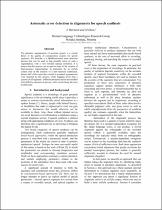JavaScript is disabled for your browser. Some features of this site may not work without it.
- ResearchSpace
- →
- Research Publications/Outputs
- →
- Conference Publications
- →
- View Item
| dc.contributor.author |
Barnard, E

|
|
| dc.contributor.author |
Davel, M

|
|
| dc.date.accessioned | 2007-07-27T10:00:56Z | |
| dc.date.available | 2007-07-27T10:00:56Z | |
| dc.date.issued | 2006-11 | |
| dc.identifier.citation | Barnard, E and Davel, M. 2006. Automatic error detection in alignments for speech synthesis. 17th Annual Symposium of the Pattern Recognition Association of South Africa, Parys, South Africa, 29 Nov - 1 Dec 2006, pp 4 | en |
| dc.identifier.isbn | 978-0-620-37384-5 | |
| dc.identifier.uri | http://hdl.handle.net/10204/1044 | |
| dc.description.abstract | The phonetic segmentation of recorded speech is a crucial factor in the quality of concatenative systems for speech synthesis. The authors describe a likelihood-based error detection process that can be used to flag possible errors in such a segmentation, with a view towards manual correction. It is shown that this process can be used to assist in the creation of high-accuracy segmentations. In particular, for an isiZulu corpus used in the creation of a unit-selection synthesizer, almost half of the errors that existed in a manual segmentation were detected by this process, while flagging less than a quarter of all segments. Different phoneme classes are handled with differing amounts of success, with vowels being the most troublesome | en |
| dc.language.iso | en | en |
| dc.subject | Speech synthesizer | en |
| dc.subject | Phonetic segmentation | en |
| dc.subject | Error detection | en |
| dc.subject | Unit-selection synthesizer | en |
| dc.title | Automatic error detection in alignments for speech synthesis | en |
| dc.type | Conference Presentation | en |
| dc.identifier.apacitation | Barnard, E., & Davel, M. (2006). Automatic error detection in alignments for speech synthesis. http://hdl.handle.net/10204/1044 | en_ZA |
| dc.identifier.chicagocitation | Barnard, E, and M Davel. "Automatic error detection in alignments for speech synthesis." (2006): http://hdl.handle.net/10204/1044 | en_ZA |
| dc.identifier.vancouvercitation | Barnard E, Davel M, Automatic error detection in alignments for speech synthesis; 2006. http://hdl.handle.net/10204/1044 . | en_ZA |
| dc.identifier.ris | TY - Conference Presentation AU - Barnard, E AU - Davel, M AB - The phonetic segmentation of recorded speech is a crucial factor in the quality of concatenative systems for speech synthesis. The authors describe a likelihood-based error detection process that can be used to flag possible errors in such a segmentation, with a view towards manual correction. It is shown that this process can be used to assist in the creation of high-accuracy segmentations. In particular, for an isiZulu corpus used in the creation of a unit-selection synthesizer, almost half of the errors that existed in a manual segmentation were detected by this process, while flagging less than a quarter of all segments. Different phoneme classes are handled with differing amounts of success, with vowels being the most troublesome DA - 2006-11 DB - ResearchSpace DP - CSIR KW - Speech synthesizer KW - Phonetic segmentation KW - Error detection KW - Unit-selection synthesizer LK - https://researchspace.csir.co.za PY - 2006 SM - 978-0-620-37384-5 T1 - Automatic error detection in alignments for speech synthesis TI - Automatic error detection in alignments for speech synthesis UR - http://hdl.handle.net/10204/1044 ER - | en_ZA |






